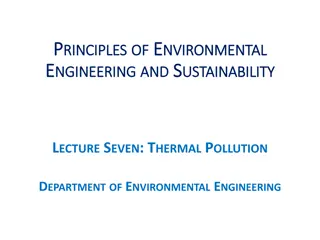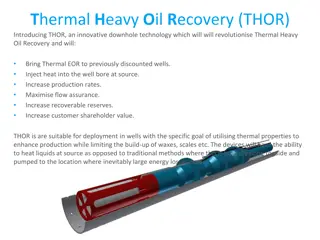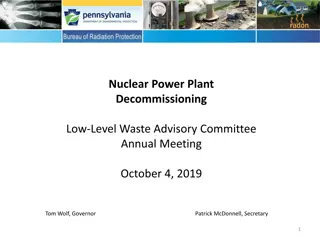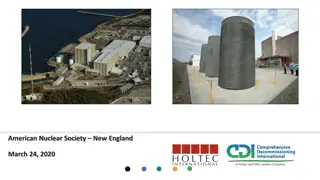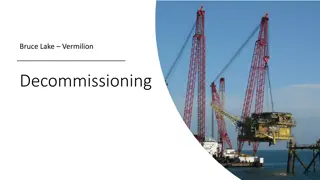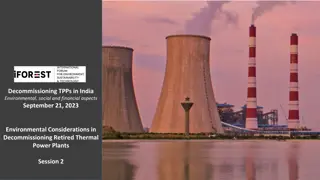Challenges and Considerations in Decommissioning Thermal Power Plants in India
Decommissioning thermal power plants (TPPs) in India involves a range of activities, from dismantling infrastructure and handling hazardous waste to environmental remediation and managing social impacts. Regulatory guidance is crucial for planning and executing decommissioning projects. With a substantial number of TPPs currently being retired and more planned for the future, there is a growing need to address the environmental, social, and financial aspects of decommissioning. The decommissioning process is complex, involving multi-dimensional considerations such as dealing with hazardous wastes, reclaiming ash ponds, and addressing social and financial challenges. Adequate guidance on decommissioning is essential, and legal/regulatory bodies are recognizing the need for developing appropriate guidelines.
Download Presentation

Please find below an Image/Link to download the presentation.
The content on the website is provided AS IS for your information and personal use only. It may not be sold, licensed, or shared on other websites without obtaining consent from the author.If you encounter any issues during the download, it is possible that the publisher has removed the file from their server.
You are allowed to download the files provided on this website for personal or commercial use, subject to the condition that they are used lawfully. All files are the property of their respective owners.
The content on the website is provided AS IS for your information and personal use only. It may not be sold, licensed, or shared on other websites without obtaining consent from the author.
E N D
Presentation Transcript
Decommissioning TPPs in India Environmental, social and financial aspects September 21, 2023 Inaugural Session
End of life activities at a power plant/unit Retirement Decommissioning Redevelopment or repurposing Removing equipment & materials from plant/unit site Dismantling infrastructure (as required) Hazardous & other waste management handling and removal Environmental remediation of plant site, especially ash pond Management of social impact (workers & community)
Why is regulatory guidance important for planning and executing thermal plant/unit decommissioning projects?
Substantial number of decommissioning projects are currently ongoing, and planned for future Over the past decade, 18.4 GW of thermal capacity across 260 units has been retired from operations. Limited number of retired units being replaced by new thermal capacity 2.7 GW out of 12 GW retired since 2016. Over the medium term, additional 2.1 GW is planned for retirement till 2032 (as per the CEA generation plan). However, it will pick up pace over longer-term, as energy security is ensured through alternate sources, as over 1/5th of installed thermal capacity has already primed for decommissioning. Retired thermal capacity in India 4,500 60 4,000 50 3,500 3,000 40 2,500 30 2,000 1,500 20 1,000 10 500 - 0 Retired capacity (MW) No of Units
Decommissioning is a complex activity with multi-dimensional considerations Plant/unit dismantling involves dealing with hazardous wastes, toxic materials, construction and demolition waste. Plant sites also require environmental remediation, especially to reclaim ash ponds. Environmental Power plants provide substantial employment 2 formal and 2.5 informal workers per MW. Informal and contractual labour compensation and reemployment major issue during decommissioning. Existing social security net inadequate in this context. Social Direct and indirect costs involved in decommissioning, estimated to be $50,000 to $150,000 per MW. Existing tariff mechanism doesn t account for recovery of decommissioning costs. Financial Coal-based TPPs occupy substantial land area - 1259 km2 in aggregate. No efficient mechanism in place to decide on next best use, made complicated by ownership patterns. Repurposing or reuse
Need for adequate guidance on decommissioning being steadily recognized by legal/regulatory bodies NGT (Southern Bench) orders for developing guidelines for TPP decommissioning as part of proceedings in case of Dharmesh Shah vs Union of India & Others. CERC issues Approach Paper on Terms & Conditions of Tariff Regulations 2024-29 acknowledging decommissioning costs for the first time. May 2023 July 2021 Feb 2021 Jun 2023 CEA and CPCB issue Guidelines on Design, Construction, O&M and Annual Certification of Coal Ash Ponds addressing issues of stabilization and reclamation CPCB issues Environmental Guidelines for Decommissioning a Coal/Lignite-Fired Power Plant (Draft) in consultation with CEA and MoEF&CC
Environmental aspects Environmental Guidelines for Decommissioning a Coal/Lignite-Fired Power Plant (Draft) comprehensively list relevant acts, rules and notifications, as well as introduce procedures to be followed for planning and executing decommissioning. Guidelines on Design, Construction, O&M and Annual Certification of Ash Pond establish the regulatory requirements for stabilization, reclamation and certification of abandoned ash ponds (crucial for an environmentally sound decommissioning). However, significant scope for strengthening the existing guidelines to ensure effectiveness, through introduction of time-bound mandate, as well as introduction of procedures to ease decommissioning and incentivises repurposing, simplify consents and clearances etc. A strong case for giving solid legal basis for decommissioning TPPs.
Financial aspects Understanding decommissioning costs Demolition phase Pre-demolition phase Post-demolition phase O&M costs - continued employee costs & station overheads Cost worker compensation Cost of planning for closure - ESIA studies & technical evaluations Cost of securing statutory clearances & permits Cost of tendering works Cost of identification, removal & transport of salvageable material Cost of plant demolition works Costs of separation, recycling, and disposal of demolition materials Cost of site clean-up Monitoring and management costs Environmental remediation due to groundwater/soil contamination Contingency costs due to unplanned environmental damages Cost of monitoring/manning the site, till its repurposed. Decommissioning costs can range from $50,000 to $150,000, depending on factors such as plant size, the environmental damage, decided site end use and recovered salvage value. In India, existing tariff provisions pertaining to recovery of salvage value, impairment loss of asset value, and change in law, are inadequate. If decommissioning is not made financially viable, generation companies are likely to abandon their plants in an as-it-is state due to lack of funds.
Mechanisms for recovering decommissioning costs Multiple examples exist nationally and globally of mechanisms for recovering cost of decommissioning energy assets. Typically, the recovery mechanisms allow for the accrual of funds over a long period of time, prior to the planned decommissioning. Mechanism to support nuclear power plant closure Mechanism to support coal mine closure AERB s safety manual AERB/SM/DECOM-1 in March 1998 Decommissioning levy collected as part of generation tariff and collected in a Decommissioning Fund held and managed by NPCIL on behalf of the DAE. Levy currently stands at 2 paise per unit. Guidelines for Preparation of Mining Plan for the Coal and Lignite Blocks Ministry of Coal issued December 2019 Mine owners required to open a fixed escrow account in any scheduled bank, with COO as exclusive beneficiary, prior to commencement of mining activities. Fund to be submitted Rs 900,000/hectare for opencast & Rs150,000/hectare for underground mines (2019 price) Final review of funds and closure plans undertaken five year prior to date of closure fund gap covered by the mine owner. Funds for progressive and final closure. Use of public and private funds, particularly to support any early closure scenario
CERCs approach paper for new tariff regulations for 2024-2029 Acknowledges the decommissioning costs for generation as well as transmission assets. appropriate provisions in the tariff regulations to deal with all eventualities to reduce risk perception among investors and provide the necessary clarity on such matters thus reducing litigations. Suggests net profit/net loss post decommissioning and disposal of assets may be adjusted in one go from the beneficiaries, duly depreciation. Challenge inadequate to protect owners from liability default factoring unrecovered
Recommendations for cost recovery Accrual of decommissioning costs over a long period Scenario-based mechanism based on vintage of the power plant Allowing recovery of decommissioning costs through a tariff component, to be held as a state level fund to support unit- level as well as plant level decommissioning Scenario 1 Plants with at least 5 years life Scenario 2 Plants with less than 5 years life Scenario 3 Plants closing prematurely A decommissioning tariff component introduced as part of the tariff. The amount put in a state decommissioning fund and reimbursed to plants based on decommissioning progress. One time settlement between plants and the discoms. Money deposited in state decommissioning fund and reimbursed to plants based on decommissioning progress. 1. Private deal by plant owbers to recover outstanding liabilities and decommissioning costs. 2. Corpus fund to support premature decommissioning.










